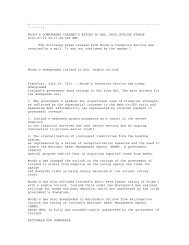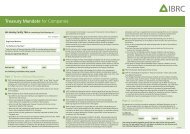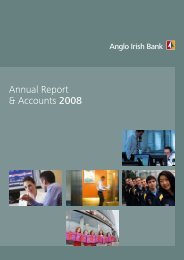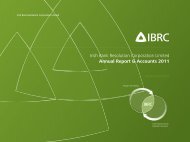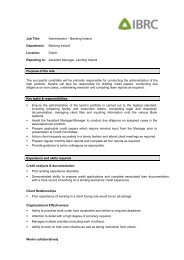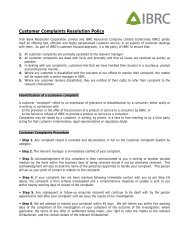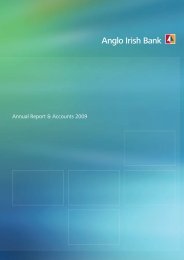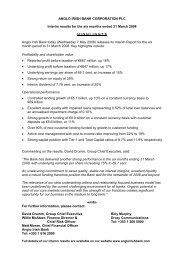IBRC annual report for 2011 - Irish Bank Resolution Corporation ...
IBRC annual report for 2011 - Irish Bank Resolution Corporation ...
IBRC annual report for 2011 - Irish Bank Resolution Corporation ...
Create successful ePaper yourself
Turn your PDF publications into a flip-book with our unique Google optimized e-Paper software.
<strong>Irish</strong> <strong>Bank</strong> <strong>Resolution</strong> <strong>Corporation</strong> LimitedAnnual Report & Accounts <strong>2011</strong>1. General in<strong>for</strong>mation and accounting policiesThe principal accounting policies that the Group applied in preparing its financial statements <strong>for</strong> the year ended 31 December <strong>2011</strong> areset out below.1.1 General in<strong>for</strong>mationAnglo <strong>Irish</strong> <strong>Bank</strong> <strong>Corporation</strong> Limited (‘the <strong>Bank</strong>’) was renamed as <strong>Irish</strong> <strong>Bank</strong> <strong>Resolution</strong> <strong>Corporation</strong> Limited on 14 October <strong>2011</strong>.The <strong>Bank</strong> and its subsidiaries (collectively, 'the Group') is a limited liability company incorporated and domiciled in Ireland (registerednumber: 22045). Its registered office is at Stephen Court, 18/21 St. Stephen's Green, Dublin 2, Ireland. Under the terms of the Anglo <strong>Irish</strong><strong>Bank</strong> <strong>Corporation</strong> Act, 2009 which became law on 21 January 2009, the <strong>Bank</strong> was taken into public ownership. Until then, the <strong>Bank</strong> hada primary listing on the <strong>Irish</strong> Stock Exchange.The <strong>Bank</strong> is a participating institution in the National Asset Management Agency (‘NAMA’) and is subject to NAMA’s statutory powers.On 8 February <strong>2011</strong> the <strong>Bank</strong> received a direction order from the High Court (the ‘Direction Order’), granted under the Credit Institutions(Stabilisation) Act 2010 (‘CISA’), which, in accordance with the provisions of the EU/IMF Programme of Financial Support <strong>for</strong> Ireland (the‘EU/IMF Programme’), confers important protections from business cessation default risk.On 24 February <strong>2011</strong>, under powers granted by CISA and following on from the Direction Order, the Minister <strong>for</strong> Finance, inconsultation with the Governor of the Central <strong>Bank</strong> of Ireland, announced the immediate transfer of the majority of the <strong>Bank</strong>’s <strong>Irish</strong> andUK deposits and €12.2bn nominal of NAMA senior bonds from the <strong>Bank</strong> (i) to Allied <strong>Irish</strong> <strong>Bank</strong>s, p.l.c. (‘AIB’) in the case of the <strong>Irish</strong>deposits and NAMA senior bonds, and (ii) to its UK subsidiary, AIB Group (UK) p.l.c. (‘AIB UK’), in the case of the UK deposits. The <strong>Bank</strong>'sshares in its Isle of Man subsidiary, Anglo <strong>Irish</strong> <strong>Bank</strong> <strong>Corporation</strong> (International) PLC, were also transferred to AIB at the same time atapproximately net asset value. The transfer order (the ‘AIB Transfer Order’) was made by the <strong>Irish</strong> High Court and facilitates the Minister’splan to restructure the <strong>Bank</strong>.On 29 June <strong>2011</strong> the European Commission (‘EC’) approved the joint restructuring and work-out plan <strong>for</strong> the Group and <strong>Irish</strong> NationwideBuilding Society (‘INBS’) (the ‘Restructuring Plan’). The approved Restructuring Plan, which was prepared in conjunction with the NationalTreasury Management Agency ('NTMA') and the Department of Finance, provides <strong>for</strong> the resolution and work-out of the Group’s loanbook over a period of up to ten years. One of the main aims of the Restructuring Plan is to gradually reduce the Group’s liquidity andfunding requirements over time by deleveraging the Group on a phased basis while at the same time minimising capital losses. TheRestructuring Plan also contains details of key assumptions and dependencies, including the Group’s continued reliance on central bankor similar funding. Following the EC’s approval of the Restructuring Plan, the Group’s single activity has become an orderly resolutionover a period of up to ten years, securing the best possible outcome <strong>for</strong> the taxpayer.On 1 July <strong>2011</strong>, under powers granted by CISA, and following EC approval of the Restructuring Plan, the Minister <strong>for</strong> Finance, inconsultation with the Governor of the Central <strong>Bank</strong> of Ireland, announced the immediate transfer of the assets and liabilities (with theexception of certain limited excluded liabilities) of INBS to the <strong>Bank</strong>. The transfer took place by way of a transfer order made by the <strong>Irish</strong>High Court in respect of INBS under Section 34 of CISA (the ‘INBS Transfer Order’).1.2 Basis of preparationBoth the consolidated and parent <strong>Bank</strong>'s financial statements comply with International Financial Reporting Standards ('IFRS') as adoptedby the European Union ('EU') and applicable at 31 December <strong>2011</strong>. The financial statements also comply with the requirements ofrelevant <strong>Irish</strong> legislation including the Companies Acts, 1963 to 2009, the Asset Covered Securities Acts, 2001 and 2007 and theEuropean Communities (Credit Institutions: Accounts) Regulations, 1992 as amended by the European Communities (InternationalFinancial Reporting Standards and Miscellaneous Amendments) Regulations, 2005.The financial statements have been prepared under the historical cost convention, as modified by the revaluation of certain assets andliabilities to the extent required or permitted under accounting standards as set out in the relevant accounting policies. They arepresented in euro, rounded to the nearest million.Under the framework of the EU/IMF Programme, which was agreed in December 2010, Ireland committed to a fundamental downsizingand reorganisation of the <strong>Irish</strong> banking sector. In the context of this strategy the Restructuring Plan was submitted to, and subsequentlyapproved by, the EC <strong>for</strong> the orderly work-out of the Group. The plan requires the Group to work out its exposures over a period of up toten years and assumes that the Group will continue to have access to sufficient liquidity and funding facilities from a combination of theECB and the Central <strong>Bank</strong> of Ireland. Under the terms of the plan the Group and the <strong>Bank</strong> must also continue to meet regulatory capitalrequirements during the expected resolution period. The plan seeks to minimise capital losses arising from the working out of the Group.On 8 December <strong>2011</strong> a Monitoring Trustee was approved by the EC to <strong>report</strong> on a quarterly basis <strong>for</strong> a period of three years on theGroup’s adherence to the commitments in the plan.The Group is committed to the implementation of the approved plan over the work-out period and has made significant progress againstplan targets during <strong>2011</strong>. This progress was achieved against a background of a challenging <strong>Irish</strong> and international economic outlookresulting largely from continuing uncertainty in relation to euro area sovereign debt considerations. Under the terms of the plan theGroup is committed to maintaining a minimum Tier 1 regulatory capital ratio of 8%. At 31 December <strong>2011</strong> the ratio stood at 15.1%.From the inception of the plan the Group has been dependent on secured funding from the ECB and exceptional liquidity assistance fromthe Central <strong>Bank</strong> of Ireland. This continued liquidity and funding support from monetary authorities has been essential in order <strong>for</strong> theGroup to carry on the orderly work-out of exposures over time.43





